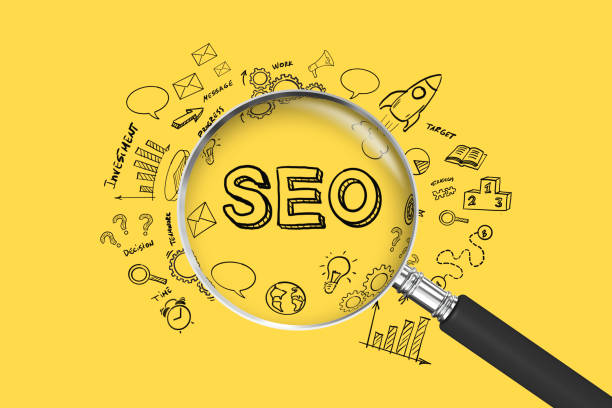An Introduction to SEO and Its Importance

In today’s digital world, an online presence is essential for every business, and therefore, Search Engine Optimization, commonly known as SEO, is no longer an option, but a necessity. SEO is a learning and complex process aimed at improving your website’s visibility in organic (non-paid) search engine results like Google. When users search for specific information, products, or services, they generally pay attention to the first search results, and websites appearing on the initial pages have a greater chance of attracting Organic Traffic and potential customers.
The importance of SEO lies in providing a long-term and sustainable Marketing Strategy that, unlike paid advertising, does not require payment per click.
This explanatory approach not only helps increase website visits but also boosts user trust and credibility in your brand.
The higher your website’s ranking in search results, the more people will find you, which means more opportunities to convert visitors into loyal customers.
A deep understanding of how search engines work and the factors they use to rank websites is among the vital parts of the SEO learning process.
This knowledge allows you to optimize your website’s content and structure in a way that is appealing to both users and search engine bots.
Are you tired of your company’s website not being seen as it should be, losing potential customers? Solve this problem forever with professional and effective website design by Rasawweb!
✅ Increase brand credibility and gain customer trust
✅ Attract targeted sales leads
⚡ Contact us now for a free consultation!
Types of SEO and Its Strategies

To achieve a successful SEO strategy, it is necessary to become familiar with its different types and correctly implement the strategies related to each section. Three main categories exist in SEO: On-page SEO, Off-page SEO, and Technical SEO.
On-page SEO refers to all optimizations performed within your website and for its content.
This includes the correct use of keywords in titles, meta descriptions, headings, and body text, image optimization, and improving user experience (UX) across various pages.
The goal of on-page SEO is to create content that is both useful and engaging for users, and understandable and relevant for search engines.
This section requires a specialized approach for keyword analysis and content structuring.
Off-page SEO refers to activities performed outside your website that, however, influence its ranking. The most important part of off-page SEO is backlink building from reputable and relevant websites.
Backlinks are considered a kind of “vote of confidence” from other sites to your content, and the higher their number and quality, the more authoritative your domain will become in the eyes of search engines.
Activities such as social media marketing, participation in forums and communities, and online branding are also considered part of off-page SEO.
The guidance section in this area is vital, as incorrect backlink building can lead to severe penalties from Google.
Technical SEO deals with optimizing the technical infrastructure of the website so that search engines can easily crawl, index, and understand its content. This includes improving site loading speed, mobile responsiveness, URL structure, using sitemaps and robots.txt files, and managing 404 errors.
The technical aspect of SEO plays a key role in ensuring the site’s technical health and its accessibility for search engines.
Without strong technical SEO, even the best content and backlinks cannot help your website achieve high rankings.
Correct and synchronized implementation of these three types of SEO will pave the way for your success in attracting organic traffic.
Keyword Research: The Main Pillar of SEO

Keyword research is the beating heart of every successful SEO strategy. Without understanding exactly what your audience is searching for, you cannot produce relevant and optimized content.
This process involves finding words and phrases that users enter into search engines and that are relevant to your business, products, or services.
The main goal is to identify keywords that have a suitable search volume and reasonable competition.
Various tools exist for keyword research, including Google Keyword Planner, Ahrefs, Semrush, and Moz Keyword Explorer, which help you discover high-potential keywords.
In keyword research, paying attention to “Search Intent” is very important. Is the user looking for information (informational search), intending to buy (commercial search), or wanting to go to a specific website (navigational search)? Understanding this helps you produce content that precisely meets the user’s needs.
For example, if a user is searching for “how to cook Ghormeh Sabzi”, they need a recipe, not a list of restaurants.
Long-tail keywords, which consist of three or more words, often have lower search volume but much higher specificity and can attract higher-quality traffic.
These types of keywords usually also have less competition, and optimizing for them is easier.
Part of the analytical approach in keyword research involves examining competitor keywords and also finding LSI (Latent Semantic Indexing) keywords. LSI keywords are phrases that are semantically related to your main keyword and help search engines better understand the core topic of your content.
This approach helps SEO provide more comprehensive and higher-quality content.
Keyword research is not a one-time process; rather, it requires continuous review and updating to keep pace with changes in user search behavior and search engine algorithms.
Table 1: Types of Keywords and Their Search Intent
| Keyword Type | Example | Search Intent | Suitable Content Type |
|---|---|---|---|
| Informational | “What is SEO” | Gaining information and knowledge | Articles, guides, Wikipedia |
| Navigational | “Instagram login” | Accessing a specific site or page | Homepage, login page, contact us |
| Commercial (Investigational) | “Best laptop for programming” | Pre-purchase research | Comparisons, product reviews, lists |
| Transactional (Purchase) | “Buy iPhone 12” | Intention to purchase product or service | Product pages, service pages, shopping cart |
SEO-Optimized Content

Content is king in SEO. Producing high-quality, relevant, and valuable content not only attracts users but also compels search engines to rank your website higher.
SEO-optimized content goes beyond merely including keywords; rather, it should answer user questions, solve their problems, and provide a rich experience.
This content should be comprehensive, accurate, and trustworthy.
To create optimized content, you must first identify appropriate keywords through keyword research. Then, build your content around these main and related keywords.
This includes using keywords in article titles, meta descriptions, headings (H1, H2, H3), and in the main text naturally and without overdoing it.
Excessive use of keywords (Keyword Stuffing) not only harms your SEO but can also lead to penalties from search engines.
Variety in content format is also important. In addition to text articles, you can use videos, infographics, podcasts, and interactive tools.
Engaging and visual content keeps users more involved and increases their time on site, which is an important factor in SEO ranking.
Creating thought-provoking content that encourages users to think and interact can lead to more social media shares and natural backlink acquisition.
Furthermore, your content should be up-to-date and fresh. Google’s algorithms give more importance to fresher and more relevant content.
Therefore, regular review and updating of old content are essential to maintain SEO rankings.
Internal linking between different pages of your website also helps search engines better understand your site’s structure and crawl deeper pages.
This also improves user experience and encourages users to discover more content.
Ultimately, content quality should be a priority; truly valuable content naturally rises in search results and drives targeted traffic to your site.
How much does losing business leads due to an unprofessional website cost you? Solve this problem forever with professional corporate website design by Rasawweb!
✅ Increase credibility and trust of potential customers
✅ Easier attraction of new business leads
⚡ Get a free consultation now!
Technical SEO: Website Infrastructure Optimization

Technical SEO is the foundation of any successful SEO strategy. Even with the best content and strongest backlinks, without a robust technical infrastructure, your website cannot be fully crawled and indexed by search engines.
This part of SEO focuses on improving website performance technically to maximize user experience and search engine crawlability.
One of the most important aspects of technical SEO is site loading speed. Both users and search engines prefer websites that load quickly.
Tools like Google PageSpeed Insights can help you identify weaknesses and improve site speed.
Image optimization, code compression (CSS, JavaScript, HTML), and using Content Delivery Networks (CDNs) are among the solutions for increasing speed.
Mobile-Friendliness is also another vital factor. Given the significant increase in mobile usage for searching, Google has adopted a “Mobile-First Indexing” approach for years, meaning your site’s mobile version is prioritized for ranking.
Your website should be fully responsive and usable across various devices.
Other aspects of technical SEO include managing crawl errors, creating an XML Sitemap, and the robots.txt file. The sitemap helps search engines find and index all important pages of your site.
The robots.txt file also tells search engines which parts of the site should not be crawled.
Proper URL management, using SSL certificates for security (HTTPS), and structured data (Schema Markup) that helps search engines better understand your content and display it more richly in search results, are also considered specialized tasks in the field of technical SEO.
Optimizing these factors ensures that your efforts in content and backlink building are not wasted, and your website is fundamentally ready to achieve high SEO rankings.
Off-page SEO and Building Powerful Backlinks
![]()
Off-page SEO refers to all activities performed outside your website that directly impact its authority and ranking in search engines. The main focus of off-page SEO is backlink building.
Backlinks are links given from other websites to your site and play a crucial role in search engines’ understanding of your site’s authority, power, and thematic relevance.
Each backlink from a reputable site is like a vote of confidence in your content.
The quality of backlinks is much more important than their quantity. One backlink from a reputable website relevant to your field is worth far more than several backlinks from low-authority or irrelevant sites.
Various methods exist for building backlinks, which can be broadly divided into “White Hat” and “Black Hat” categories.
White Hat methods, approved by search engines, include producing very high-quality and valuable content that naturally attracts links, guiding other sites to link to you, guest posting on other websites, and using social media to increase content visibility.
On the other hand, Black Hat methods such as buying backlinks, excessive link exchange, or using PBNs (Private Blog Networks) are strongly condemned by Google and can lead to severe penalties (Manual Penalties) for your site. These penalties can include complete removal of your site from search results.
Therefore, focusing on building natural and high-quality backlinks that add real value to users is essential.
In addition to backlinks, social media activity and increasing online brand reputation also indirectly affect SEO. Although social media links are not directly considered backlinks, they can help increase content visibility, attract more visitors to the site, and ultimately help acquire natural backlinks.
Brand name monitoring and using competitor backlink analysis tools to identify new opportunities for backlink building are also considered part of the off-page SEO strategy.
A comprehensive off-page SEO strategy ensures the stability and long-term growth of your website in search engine optimization results.
Data Analysis and Continuous SEO Improvement

After implementing SEO strategies, the most important next step is continuous performance monitoring and data analysis for ongoing improvement. SEO is not a static process; rather, it requires continuous monitoring, evaluation, and optimization to keep pace with changes in search engine algorithms and user behavior.
Numerous analytical tools are available that can provide valuable information.
Google Analytics is one of the most powerful tools for tracking website traffic, user behavior, traffic sources, and conversion rates. Using this tool, you can see how users interact with your site, which pages are most popular, and where they came from.
This information helps you adjust your content and marketing strategy based on real data.
For example, if you notice that users are leaving a specific page at a high rate (high Bounce Rate), you can improve that page’s content or design.
Google Search Console (formerly Webmaster Tools) is another vital tool that provides direct insights into how your site appears in search results. This tool provides information about the keywords your site ranks for, the number of clicks and impressions, crawl errors, and page indexing status.
Also, through Search Console, you can view manual Google penalties and request a review.
This news and analytical information is extremely valuable for identifying technical issues and new opportunities for search engine optimization.
In addition to these tools, using advanced SEO tools like Ahrefs, Semrush, and Moz is also recommended for competitor analysis, backlink review, and identifying keyword opportunities. A/B testing to compare the performance of different versions of a page or specific element on the site can help you find the optimal state for users and search engines.
This data-driven approach ensures that your SEO efforts are effective and continuously lead to improved rankings and website traffic.
Continuous optimization based on real data is the key to sustainable success in the dynamic world of SEO.
Table 2: Key SEO Metrics and Their Importance
| Metric | Definition | Importance for SEO |
|---|---|---|
| Organic Traffic | Visitors who come to the site through search results. | The ultimate goal of SEO; indicates strategy success. |
| Keyword Ranking | Site’s position for specific keywords in search results. | Indicates visibility and potential for traffic attraction. |
| Bounce Rate | Percentage of visitors who view only one page and then leave. | High bounce rate can indicate irrelevant content or poor user experience. |
| Time on Site | The duration users spend on your site. | Longer time on site indicates content attractiveness and value. |
| Click-Through Rate (CTR) | Percentage of clicks based on the number of impressions in search results. | Indicates the attractiveness of the title and meta description to users. |
| Backlinks | Links from other websites to your site. | Important factor in determining domain authority and power. |
The Role of User Experience (UX) in SEO

User Experience (UX) and SEO are no longer two separate fields; rather, they are increasingly intertwined. Search engines, especially Google, are increasingly incorporating user experience factors into their ranking algorithms.
Google’s main goal is to provide the best and most relevant results to users, and a website with a poor user experience, even with excellent content, cannot fulfill this goal.
Therefore, UX optimization directly impacts SEO.
One of the most important UX factors that Google pays special attention to is Core Web Vitals. These vital metrics include three main components: LCP (Largest Contentful Paint), which measures the loading time of the largest visible content on the page; FID (First Input Delay), which addresses the site’s responsiveness to the user’s first interaction; and CLS (Cumulative Layout Shift), which assesses the visual stability of the page (preventing sudden shifts of page elements).
Improving these metrics not only enhances user experience but also sends positive signals to Google that your site is optimized for users, which helps improve SEO rankings.
Other UX aspects that affect SEO include easy navigation, a clear and logical site structure, responsive design for various devices, and content readability. If users cannot easily find what they are looking for or get lost on your site, they will quickly leave.
This leads to an increased bounce rate and decreased time on site, which are negative signals for search engines.
Providing a clear and explanatory overview of products or services, as well as answering frequently asked questions, can help improve user experience and, consequently, SEO.
Finally, user feedback and user testing are also vital for identifying UX issues and continuously improving them. A well-designed website that provides a positive user experience not only keeps visitors satisfied but also makes them stay longer on the site, view more pages, and ultimately convert into customers.
This positive cycle leads to increased rankings in search results and sustainable growth in the field of search engine optimization.
Are you tired of losing business opportunities due to lacking a professional corporate website?
Rasawweb, with professional corporate website design, helps you:
✅ Build a powerful and reliable brand image
✅ Convert website visitors into loyal customers
⚡ Get a free consultation now!
SEO Algorithm Changes and Their Challenges

The world of SEO is constantly changing, and these changes are primarily due to continuous updates in search engine algorithms, especially Google’s. Google implements hundreds, even thousands, of minor and major changes to its algorithm annually, some of which can have significant impacts on website rankings.
Understanding these updates and how to react to them is a vital and specialized aspect of SEO management.
Some of Google’s most famous updates include Panda, Penguin, and Hummingbird, each focusing on specific aspects of SEO. The Panda update focused on content quality and removing low-value and duplicate content.
Penguin targeted spammy and low-quality links, penalizing sites that used Black Hat methods for backlink building.
Hummingbird also focused on understanding the semantic meaning of searches and user intent.
Today, “Core Updates” or major Google updates, which usually occur several times a year, have the most significant impact. These updates are more comprehensive and can affect a wide range of ranking factors.
Google usually does not release the precise details of these updates, but news and analyses from SEO experts can help us understand their direction.
The main challenge here is that webmasters and SEO specialists must always be vigilant and identify the impact of these updates by continuously monitoring their site’s performance and observing changes in search results.
To cope with these challenges, the best approach is to focus on fundamental SEO principles and provide real value to users. Producing high-quality and comprehensive content, building natural and authoritative backlinks, improving user experience, and technical site optimization are strategies that will be more resilient to algorithm changes.
Furthermore, having an analytical approach and readiness to adapt quickly to new conditions are essential for maintaining and improving rankings in search results.
This dynamism in the field of SEO is both challenging and creates new opportunities for websites that adhere to best practices.
The Future of SEO and Emerging Trends
![]()
The world of SEO never stays constant, and new trends always emerge with the advent of new technologies and changes in user behavior. It is essential for specialists and businesses to be familiar with these emerging trends so they can prepare their search engine optimization strategies for the future.
This section provides guidance on the most important future SEO trends.
One of the most prominent future trends is Voice Search. With the proliferation of voice assistants like Siri, Google Assistant, and Alexa, the number of voice searches is increasing.
These types of searches are usually longer, more conversational, and resemble natural questions.
Optimizing content for voice search means focusing on long-tail keywords and direct answers to questions.
Artificial Intelligence (AI) and Machine Learning are also playing an increasing role in SEO. Algorithms like Google’s RankBrain use AI to better understand the meaning of searches and provide more relevant results.
This means that focusing on producing high-quality, comprehensive content relevant to user intent has become more important than ever.
E-A-T (Expertise, Authoritativeness, Trustworthiness) is a criterion that Google highly considers for evaluating the quality of content and websites, especially in sensitive areas like health and finance.
Video SEO is also of high importance. With the increasing consumption of video content, optimizing videos for search engines (through titles, descriptions, tags, and text transcripts) can help attract significant traffic.
Local SEO is also vital for physical businesses.
Optimizing for “near me” searches and managing your Google My Business profile are very important for attracting local customers.
Training in these new trends helps professionals stay ahead of competitors.
The emphasis on User Experience (UX) and Core Web Vitals will also continue. Search engines are increasingly paying attention to the quality of user experience on the site.
Therefore, a fast, responsive, and easy-to-use website is of high importance.
By following these future trends, businesses can optimize their SEO strategy for sustainable success in the evolving digital environment.
Frequently Asked Questions
| Question | Answer |
|---|---|
| What is SEO? | SEO, or Search Engine Optimization, is a process for increasing the quality and quantity of website traffic by improving the site’s ranking in natural (organic) search engine results like Google. |
| What are the main types of SEO? | SEO is divided into three main categories: On-Page SEO, Off-Page SEO, and Technical SEO. |
| What does On-Page SEO include? | On-Page SEO includes optimizing elements within the website, such as keywords, Title Tags, Meta Descriptions, content, URL structure, images, and internal links. |
| What is Off-Page SEO? | Off-Page SEO refers to activities outside the website that help improve its ranking, such as Backlink Building, social media marketing, and Brand Mentions. |
| What is Technical SEO? | Technical SEO focuses on optimizing the technical aspects of a website to help it be better crawled and indexed by search engines. This includes site speed, mobile-friendliness, site structure, Sitemaps, and the Robots.txt file. |
| What role do Keywords play in SEO? | Keywords are phrases that users enter into search engines. Correct and targeted use of relevant keywords in content and site elements helps search engines understand your page’s topic and display it for relevant searches. |
| What is a Backlink and why is it important? | A backlink, or inbound link, is a link from one website to another. Backlinks act as a “vote of confidence” from other sites for search engines and play an important role in a site’s authority and ranking increase, especially if they come from reputable sites. |
| What is the impact of quality content on SEO? | High-quality, relevant, comprehensive, and unique content not only attracts and retains users but also shows search engines that your page is valuable. This helps improve ranking, reduce Bounce Rate, and increase user time on site. |
| Why is site loading speed important for SEO? | Site loading speed is an important ranking factor for Google. Faster sites offer a better user experience, have lower bounce rates, and are preferred by search engines. |
| Is SEO a one-time process? | No, SEO is a continuous and long-term process. Search engine algorithms are constantly changing, competition is increasing, and site content also needs updating. Therefore, SEO requires continuous monitoring, analysis, and optimization. |
And other services of RasaWeb Advertising Agency in the field of advertising
Smart Marketing Automation: A professional solution for improving SEO ranking with a focus on attractive user interface design.
Smart Sales Automation: An effective tool to increase sales with the help of Google Ads management.
Smart Direct Marketing: A combination of creativity and technology for campaign management through key page optimization.
Smart Advertorials: A professional solution for user engagement with a focus on attractive user interface design.
Smart Brand Identity: Revolutionize campaign management with the help of precise audience targeting.
And over hundreds of other services in the fields of internet advertising, advertising consulting, and organizational solutions
Internet Advertising | Advertising Strategy | Advertorials
Sources
What is SEO?What is On-Page SEO?Comprehensive SEO GuideComprehensive SEO and Optimization Training
Is your business ready to leap into the digital future? Rasaweb Afarin Digital Marketing Agency, by offering comprehensive services including website design with modern user interface, SEO, and social media management, paves your path to success. Contact us today and transform the future of your brand.
📍 Tehran, Mirdamad Street, next to Central Bank, Southern Kazeroun Alley, Ramin Alley, No. 6




